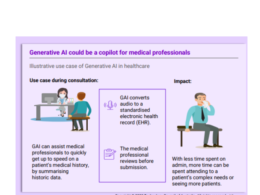the health strategist
knowledge platform
for health management, engineering
and technology
Joaquim Cardoso MSc.
Chief Research and Strategy Officer (CRSO);
Chief Editor and Senior Advisor
August 2, 2023
What is the message?
Generative AI (gen AI) has experienced explosive growth and adoption in 2023.
It has moved from being a topic primarily discussed among tech employees to becoming a focus for company leaders, with one-third of survey respondents reporting regular use of gen AI tools in at least one business function.
The text highlights that AI high performers, organizations that have already embedded AI capabilities, are leading in the adoption of gen AI tools and are seeing the most value from traditional AI capabilities.
However, despite the significant adoption of gen AI, the findings indicate that organizations are still in the early stages of managing gen AI-related risks, with a notable focus on addressing accuracy issues.
The expected business disruption from gen AI is significant, and respondents predict workforce changes, including potential cuts in certain areas and the need for extensive reskilling efforts to address shifting talent needs.
On the other hand, the adoption of other AI technologies has not seen significant increases, with only a small number of business functions concentrating AI adoption, and overall AI tool adoption has held steady since 2022.
This is an excerpt of the report “
Infographic
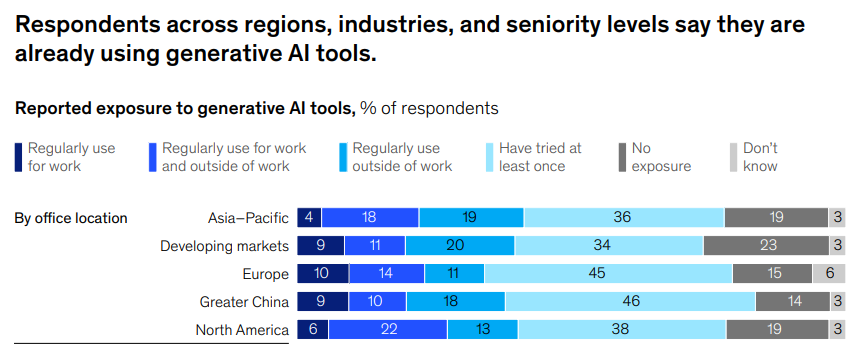
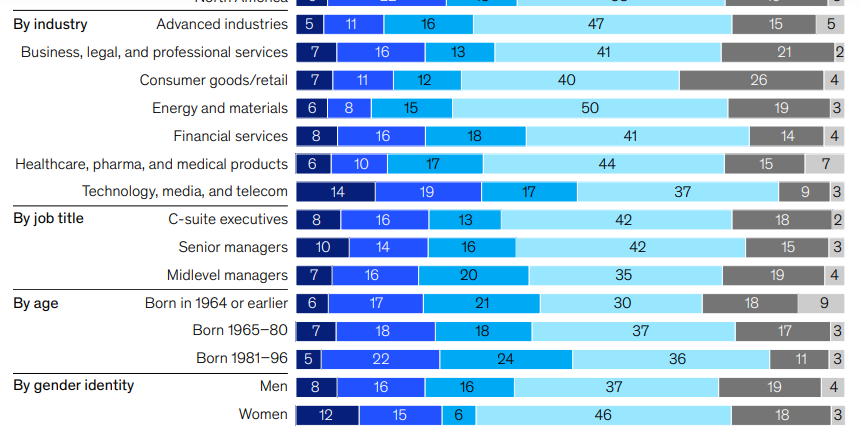
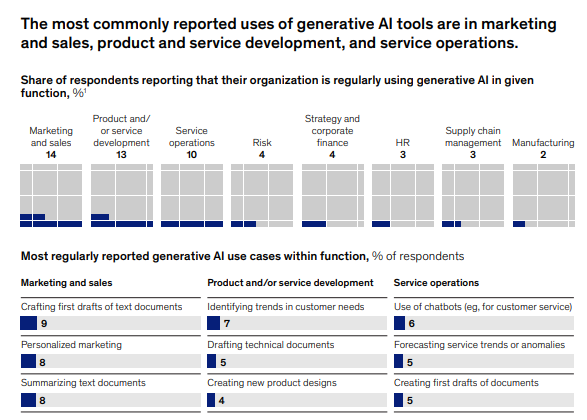
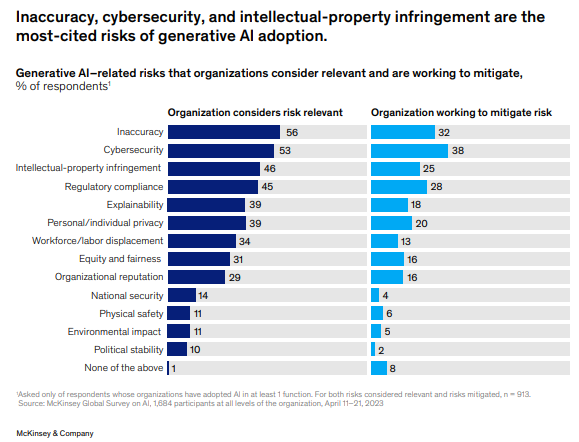
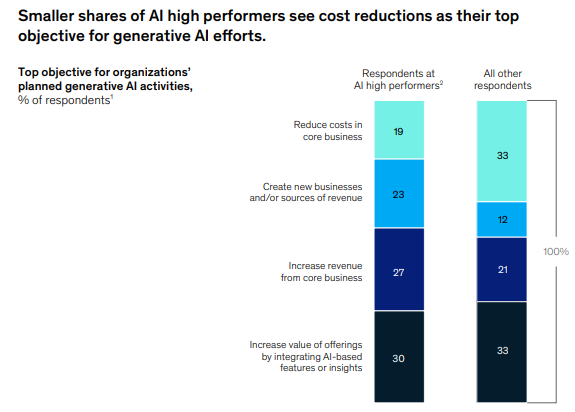
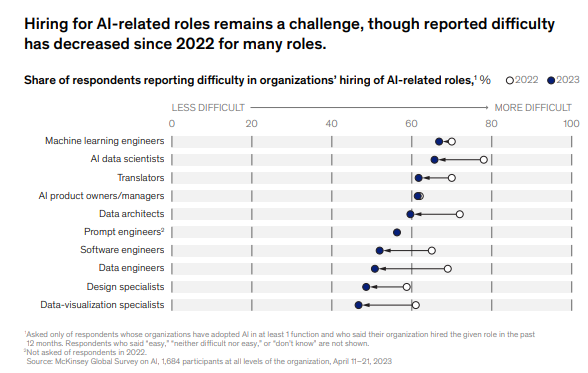
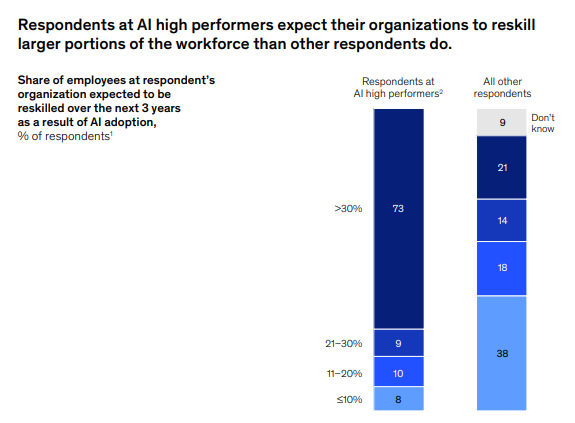
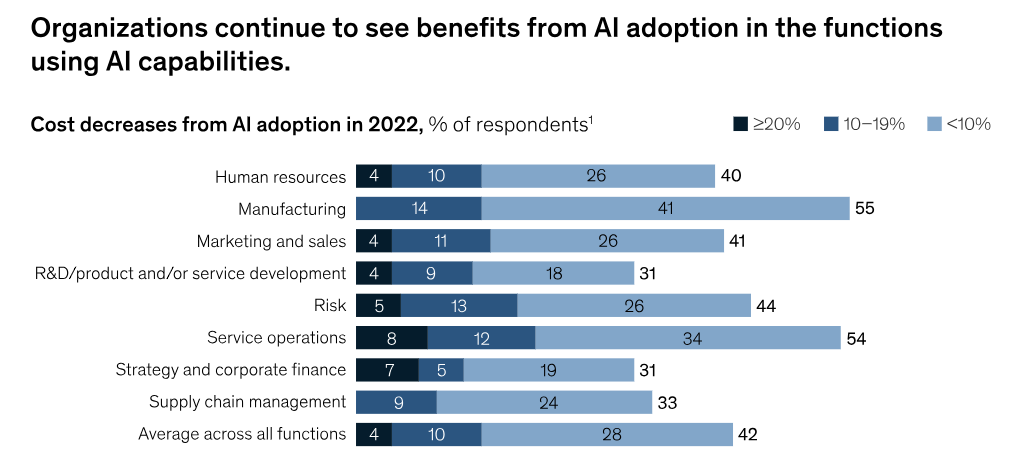
DEEP DIVE

The state of AI in 2023: Generative AI’s breakout year [Executive Summary]
As organizations rapidly deploy generative AI tools, survey respondents expect significant effects on their industries and workforces.
McKinsey Global Institute
Michael Chui, Lareina Yee; Bryce Hall, Alex Singla and Alexander Sukharevsky,
August, 2023
This is an excerpt of the report “The state of AI in 2023: Generative AI’s breakout year”, published by MGI (McKinsey Global Institute), authored by Michael Chui, Lareina Yee; Bryce Hall, Alex Singla and Alexander Sukharevsky, an issued on August, 2023.
The latest annual McKinsey Global Survey on the current state of AI confirms the explosive growth of generative AI (gen AI) tools.
Less than a year after many of these tools debuted, one-third of our survey respondents say their organizations are using gen AI regularly in at least one business function.
Amid recent advances, AI has risen from a topic relegated to tech employees to a focus of company leaders:
- nearly one-quarter of surveyed C-suite executives say they are personally using gen AI tools for work, and
- more than one-quarter of respondents from companies using AI say gen AI is already on their boards’ agendas.
What’s more, 40 percent of respondents say their organizations will increase their investment in AI overall because of advances in gen AI.
The findings show that these are still early days for managing gen AI-related risks, …
… with less than half of respondents saying their organizations are mitigating even the risk they consider most relevant: inaccuracy.
The organizations that have already embedded AI capabilities have been the first to explore gen AI’s potential, and those seeing the most value from more traditional AI capabilities- …
… a group we call AI high performers-are already outpacing others in their adoption of gen AI tools.
The expected business disruption from gen AI is significant, and respondents predict meaningful changes to their workforces.
They anticipate workforce cuts in certain areas and large reskilling efforts to address shifting talent needs.
Yet while the use of gen AI might spur the adoption of other AI tools, we see few meaningful increases in organizations’ adoption of these technologies.
The percent of organizations adopting any AI tools has held steady since 2022, and adoption remains concentrated within a small number of business functions.
Table of Contents
- It’s early days still, but use of gen AI is already widespread
- Leading companies are already ahead with gen AI
- AI-related talent needs shift, and AI’s workforce effects are expected to be substantial
- With all eyes on gen AI, AI adoption and impact remain steady
- About the research

1. It’s early days still, but use of gen AI is already widespread
The findings from the survey-which was in the field in mid-April 2023-show that, despite gen AI’s nascent public availability, experimentation with the tools is already relatively common, and respondents expect the new capabilities to transform their industries. Gen AI has captured interest across the business population: individuals across regions, industries, and seniority levels are using gen AI for work and outside of work. Seventy-nine percent of all respondents say they’ve had at least some exposure to gen AI, either for work or outside of work, and 22 percent say they are regularly using it in their own work. While reported use is quite similar across seniority levels, it is highest among respondents working in the technology sector and those in North America.


Organizations, too, are now commonly using gen AI. One-third of all respondents say their organizations are already regularly using generative AI in at least one function-meaning that 60 percent of organizations with reported AI adoption are using gen AI. What’s more, 40 percent of those reporting AI adoption at their organizations say their companies expect to invest more in AI overall thanks to generative AI, and 28 percent say generative AI use is already on their board’s agenda. The most commonly reported business functions using these newer tools are the same as those in which AI use is most common overall: marketing and sales, product and service development, and service operations, such as customer care and back-office support. This suggests that organizations are pursuing these new tools where the most value is. In our previous research, these three areas, along with software engineering, showed the potential to deliver about 75 percent of the total annual value from generative AI use cases.

In these early days, expectations for gen AI’s impact are high: three-quarters of all respondents expect gen AI to cause significant or disruptive change in the nature of their industry’s competition in the next three years. Survey respondents working in the technology and financial-services industries are the most likely to expect disruptive change from gen AI. Our previous research shows that, while all industries are indeed likely to see some degree of disruption, the level of impact is likely to vary. Industries relying most heavily on knowledge work are likely to see more disruption-and potentially reap more value. While our estimates suggest that tech companies, unsurprisingly, are poised to see the highest impact from gen AI-adding value equivalent to as much as 9 percent of global industry revenue-knowledge-based industries such as banking (up to 5 percent), pharmaceuticals and medical products (also up to 5 percent), and education (up to 4 percent) could experience significant effects as well. By contrast, manufacturing-based industries, such as aerospace, automotives, and advanced electronics, could experience less disruptive effects. This stands in contrast to the impact of previous technology waves that affected manufacturing the most and is due to gen AI’s strengths in language-based activities, as opposed to those requiring physical labor.
Responses show many organizations not yet addressing potential risks from gen AI
According to the survey, few companies seem fully prepared for the widespread use of gen AI-or the business risks these tools may bring. Just 21 percent of respondents reporting AI adoption say their organizations have established policies governing employees’ use of gen AI technologies in their work. And when we asked specifically about the risks of adopting gen AI, few respondents say their companies are mitigating the most commonly cited risk with gen AI: inaccuracy. Respondents cite inaccuracy more frequently than both cybersecurity and regulatory compliance, which were the most common risks from AI overall in previous surveys. Just 32 percent say they’re mitigating inaccuracy, a smaller percentage than the 38 percent who say they mitigate cybersecurity risks. Interestingly, this figure is significantly lower than the percentage of respondents who reported mitigating AI-related cybersecurity last year (51 percent). Overall, much as we’ve seen in previous years, most respondents say their organizations are not addressing AI-related risks.


2. Leading companies are already ahead with gen AI
The survey results show that AI high performers-that is, organizations where respondents say at least 20 percent of EBIT in 2022 was attributable to AI use-are going all in on artificial intelligence, both with gen AI and more traditional AI capabilities. These organizations that achieve significant value from AI are already using gen AI in more business functions than other organizations do, especially in product and service development and risk and supply chain management. When looking at all AI capabilities-including more traditional machine learning capabilities, robotic process automation, and chatbots-AI high performers also are much more likely than others to use AI in product and service development, for uses such as product-development-cycle optimization, adding new features to existing products, and creating new AI-based products. These organizations also are using AI more often than other organizations in risk modeling and for uses within HR such as performance management and organization design and workforce deployment optimization.
AI high performers are much more likely than others to use AI in product and service development.
Another difference from their peers: high performers’ gen AI efforts are less oriented toward cost reduction, which is a top priority at other organizations. Respondents from AI high performers are twice as likely as others to say their organizations’ top objective for gen AI is to create entirely new businesses or sources of revenue-and they’re most likely to cite the increase in the value of existing offerings through new AI-based features.

As we’ve seen in previous years, these high-performing organizations invest much more than others in AI: respondents from AI high performers are more than five times more likely than others to say they spend more than 20 percent of their digital budgets on AI. They also use AI capabilities more broadly throughout the organization. Respondents from high performers are much more likely than others to say that their organizations have adopted AI in four or more business functions and that they have embedded a higher number of AI capabilities. For example, respondents from high performers more often report embedding knowledge graphs in at least one product or business function process, in addition to gen AI and related natural-language capabilities.
While AI high performers are not immune to the challenges of capturing value from AI, the results suggest that the difficulties they face reflect their relative AI maturity, while others struggle with the more foundational, strategic elements of AI adoption. Respondents at AI high performers most often point to models and tools, such as monitoring model performance in production and retraining models as needed over time, as their top challenge. By comparison, other respondents cite strategy issues, such as setting a clearly defined AI vision that is linked with business value or finding sufficient resources.
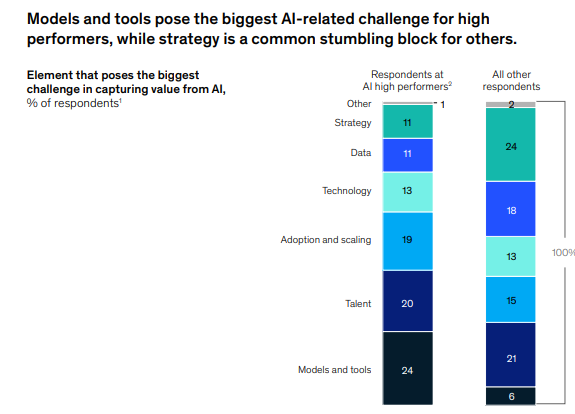
The findings offer further evidence that even high performers haven’t mastered best practices regarding AI adoption, such as machine-learning-operations (MLOps) approaches, though they are much more likely than others to do so. For example, just 35 percent of respondents at AI high performers report that where possible, their organizations assemble existing components, rather than reinvent them, but that’s a much larger share than the 19 percent of respondents from other organizations who report that practice.

Many specialized MLOps technologies and practices may be needed to adopt some of the more transformative uses cases that gen AI applications can deliver-and do so as safely as possible. Live-model operations is one such area, where monitoring systems and setting up instant alerts to enable rapid issue resolution can keep gen AI systems in check. High performers stand out in this respect but have room to grow: one-quarter of respondents from these organizations say their entire system is monitored and equipped with instant alerts, compared with just 12 percent of other respondents.
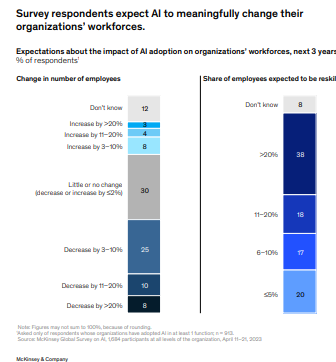
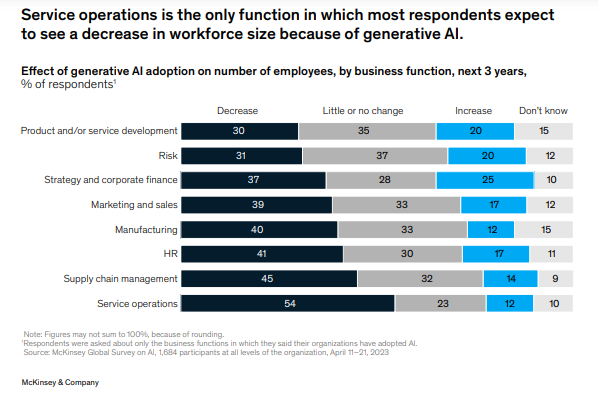

3. AI-related talent needs shift, and AI’s workforce effects are expected to be substantial
Our latest survey results show changes in the roles that organizations are filling to support their AI ambitions. In the past year, organizations using AI most often hired data engineers, machine learning engineers, and Al data scientists-all roles that respondents commonly reported hiring in the previous survey. But a much smaller share of respondents report hiring AI-related-software engineers-the most-hired role last year-than in the previous survey (28 percent in the latest survey, down from 39 percent). Roles in prompt engineering have recently emerged, as the need for that skill set rises alongside gen AI adoption, with 7 percent of respondents whose organizations have adopted AI reporting those hires in the past year.


4. With all eyes on gen AI, AI adoption and impact remain steady
While the use of gen AI tools is spreading rapidly, the survey data doesn’t show that these newer tools are propelling organizations’ overall AI adoption. The share of organizations that have adopted AI overall remains steady, at least for the moment, with 55 percent of respondents reporting that their organizations have adopted AI. Less than a third of respondents continue to say that their organizations have adopted AI in more than one business function, suggesting that AI use remains limited in scope. Product and service development and service operations continue to be the two business functions in which respondents most often report AI adoption, as was true in the previous four surveys. And overall, just 23 percent of respondents say at least 5 percent of their organizations’ EBIT last year was attributable to their use of AI-essentially flat with the previous survey-suggesting there is much more room to capture value.
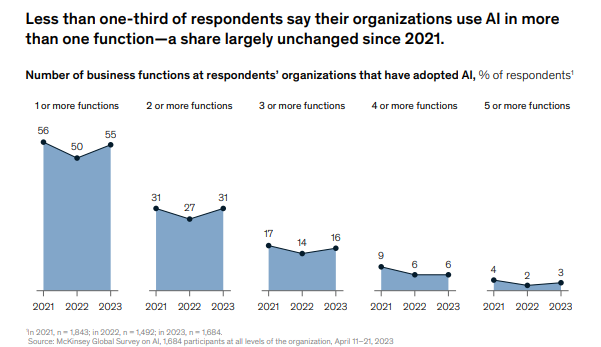
Organizations continue to see returns in the business areas in which they are using AI, and they plan to increase investment in the years ahead. We see a majority of respondents reporting AI-related revenue increases within each business function using AI. And looking ahead, more than two-thirds expect their organizations to increase their AI investment over the next three years.

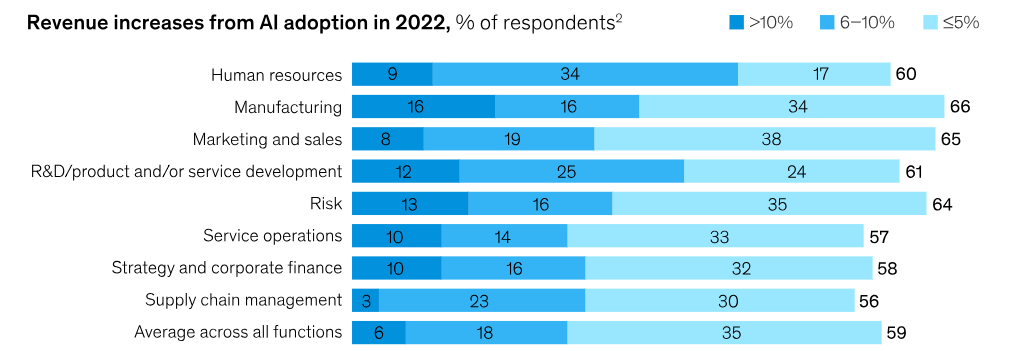

About the research
The online survey was in the field April 11 to 21, 2023, and garnered responses from 1,684 participants representing the full range of regions, industries, company sizes, functional specialties, and tenures. Of those respondents, 913 said their organizations had adopted AI in at least one function and were asked questions about their organizations’ AI use. To adjust for differences in response rates, the data are weighted by the contribution of each respondent’s nation to global
About the authors
The survey content and analysis were developed by Michael Chui, a partner at the McKinsey Global Institute and a partner in McKinsey’s Bay Area office, where Lareina Yee is a senior partner; Bryce Hall, an associate partner in the Washington, DC, office; and senior partners Alex Singla and Alexander Sukharevsky, global leaders of QuantumBlack, AI by McKinsey, based in the Chicago and London offices, respectively.
They wish to thank Shivani Gupta, Abhisek Jena, Begum Ortaoglu, Barr Seitz, and Li Zhang for their contributions to this work.
Originally published at https://www.mckinsey.com on August 1, 2023.











